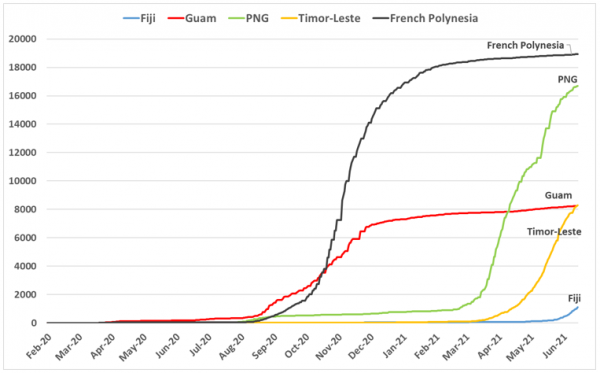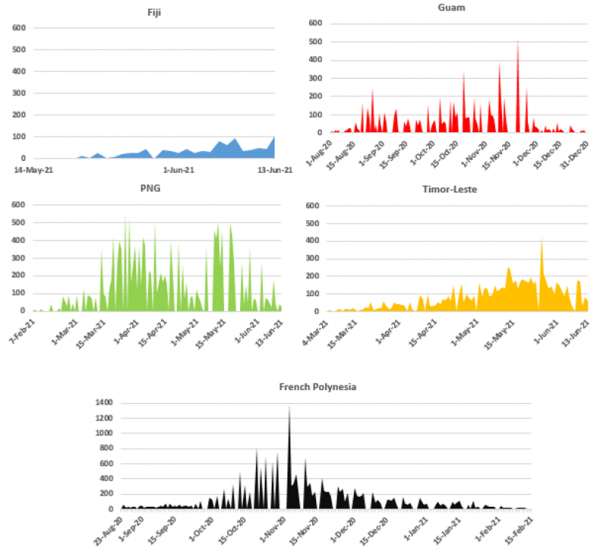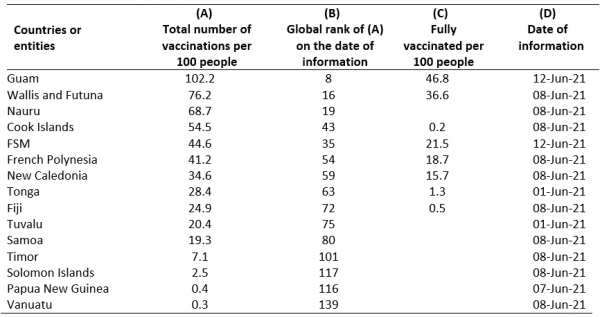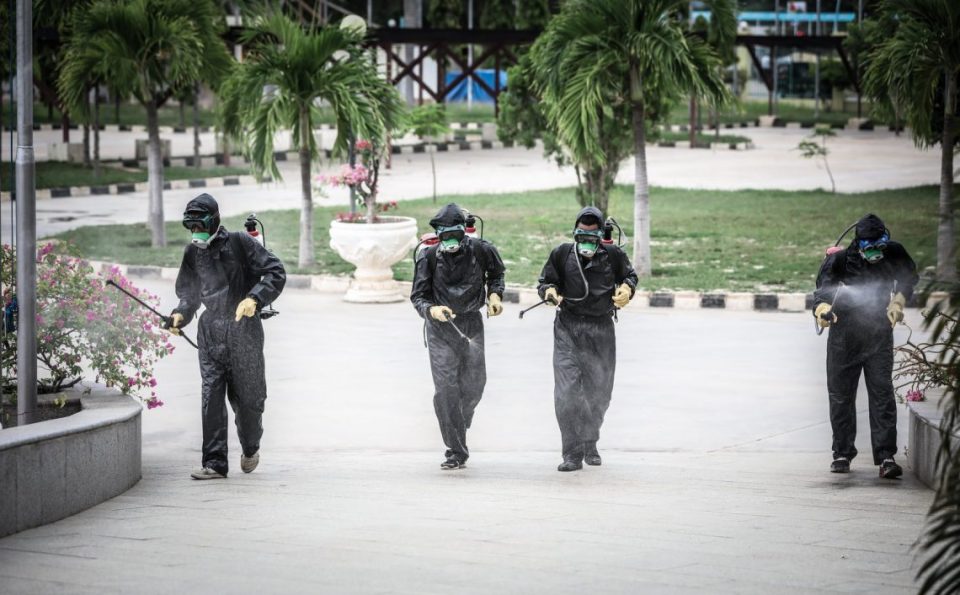by Stephen Howes, Sherman Surandiran
For a long time, the health narrative around COVID-19 in the island nations of the Pacific and Timor-Leste was quite positive. Yes, the economic costs of the pandemic were substantial, but the number of cases was low. Not anymore. The five countries most affected are French Polynesia, Guam, Papua New Guinea (PNG), Timor-Leste and Fiji.
In French Polynesia, a spike in cases between September 2020 and January 2021 saw the total case count increase about thirtyfold from 573 on 1 September 2020 to 18,060 on 31 January 2021. There are signs that French Polynesia is making progress towards controlling the spread of the virus, as the number of daily new cases began to taper off from February 2021.
Guam, a territory of the United States, witnessed a surge in cases between August and November 2020 but since then has been able to contain the number of new infections.
Case numbers took off in PNG in March 2021, climbing from a cumulative case total of 1,670 as of 8 March to 16,682 as of 13 June, a tenfold increase over three months.
In Timor-Leste, between 13 April and 13 June this year, the number of cumulative cases went up from 1,074 to 8,285 – an eightfold increase in just two months.
The most recent country to experience an outbreak in Fiji. In the ten days preceding 13 June 2021, the cumulative number of cases more than doubled from 536 to 1,118.
Wallis and Futuna have recorded 454 cases as of 20 June 2021 (high for its population of only 11,246), though its March 2021 outbreak seems to have been brought under control. New Caledonia has recorded 129 cases as of 20 June 2021.
Other Pacific countries remain relatively unaffected, with just 30 recorded cases, the most recent in Kiribati on 21 May 2021.

Sources: Our World in Data for Fiji, Timor-Leste and PNG; World Health Organisation for French Polynesia; Centers for Disease Control and Prevention for Guam
While these numbers might still seem low, they are high on a per capita basis. In particular, French Polynesia recorded a peak of 1,384 new cases on 3 November 2020 which, based on its July 2021 population estimate of 297,154 people, translated to an infection rate of 4,659 cases per million people, the highest rate globally on the day. On 20 November 2020, Guam recorded 528 new cases. Dividing this figure by its July 2021 population estimate of 168,801, its peak daily infection rate was 3,128 cases per million people, also ranking it above all other countries on the day. At Timor-Leste’s new-infections peak, on 26 May of this year, it had 325 new cases per million people, the 14th highest in the world on that day. PNG registered its peak on 26 March with 62 cases per million people, the 92nd highest in the world on that day. Cases in Fiji are still on the way up. Its 13 June count was 116 cases per million people, placing it 25th globally in terms of the number of new cases recorded per capita on the day.
The next figure shows the trajectory of new cases during peak outbreak periods for each of the five countries. Numbers may be coming down in PNG and Timor-Leste, but it is too early to say for Fiji.

Sources: Our World in Data for Fiji, Timor-Leste and PNG; World Health Organisation for French Polynesia; Centers for Disease Control and Prevention for Guam
It appears that the opening of international borders in July to visitors led to a subsequent surge in cases in French Polynesia in 2020. In the face of rising global case numbers in February 2021, it closed its borders and this, together with a comparatively quick vaccination program, has likely contributed to a decline in new daily cases.
The rise in cases starting in August last year in Guam has been linked to a number of arrivals from the US mainland at a time when earlier restrictions had been eased. In PNG, the higher numbers have been attributed to “negligence [and] skepticism”. Fiji had been boasting of its success in keeping COVID out, but its quarantine arrangements also became lax. In Timor-Leste, community cases were first detected in communities across its border with Indonesia before spreading to its capital Dili. Floods in May and the consequent temporary relaxation of COVID-19 restrictions could have also triggered the spike in case numbers.
All countries have engaged in lockdowns of various lengths and severity, which seem to have helped. Limited testing is a problem in PNG with a rolling average test rate of just 100 people per million as of 18 April (the most recent date for which we could find information). Fiji, on the hand, has been more proactive in testing, recording a 7-day rolling average of 3,725 tests per million people (as of 13 June).
The recent rise in cases makes vaccination all the more important, and not only for the four affected countries. Guam seems to be the Pacific’s vaccination leader. As of 12 June, it had fully vaccinated 47% of its population, a rate which puts it in 6th spot globally. Another leader on the vaccination front in the region is French Polynesia, with 41.2 doses issued per 100 people and 18.7% of its population fully vaccinated. This is perhaps one reason for the relatively low number of daily cases recorded recently.
The tiny island states of Cook Islands, Nauru, and Wallis and Futuna also have high vaccination rates. As of 8 June, Nauru had recorded 69 vaccinations per 100 people, ranking it 19th globally in this regard, while Wallis and Futuna had fully vaccinated 37% of its population, the 13th highest full vaccination rate in the world. Cook Islands had issued 55 vaccinations per 100 people as of 8 June but had only fully vaccinated 0.2% of its population as of the same day.

Source: Our World in Data. Note: blanks in the table indicate that data is unavailable. Latest available vaccination information for PNG is dated 7 June 2021 and it was ranked 116th on this day. Solomon Islands’ rank of 117 is as of 8 June 2021.
Fiji has 25 vaccinations per 100 people as of 8 June, the 72nd highest rate in the world. But PNG and Timor-Leste are lagging on the vaccination front. Timor-Leste has issued 7 vaccinations per 100 people and PNG has issued only 0.43 vaccinations per 100 people. The three lowest-ranked countries in the Pacific – Solomon Islands, PNG and Vanuatu – have vaccination rates similar to or lower than Africa’s average of 2.3%. (By way of comparison, Australia’s vaccination rate was 23 per 100 people as of 13 June.)
The last few months have shown that keeping COVID-19 at bay is not an assured strategy. A low level of vaccinations not only increases pandemic risks but also delays borders reopening. Getting vaccination rates up must be a top priority for the Pacific, especially in Solomon Islands, PNG, Vanuatu and Timor-Leste.
Note: This article was originally published on 18 June 2021. It was updated on 22 June 2021 to include information on Cook Islands, French Polynesia, New Caledonia, and Wallis and Futuna.
Disclosure: This research was undertaken with support from the Pacific Research Program, funded by the Department of Foreign Affairs and Trade. The views are those of the authors only.
This article appeared first on Devpolicy Blog (devpolicy.org), from the Development Policy Centre at The Australian National University.
Stephen Howes is the Director of the Development Policy Centre and a Professor of Economics at the Crawford School.
Sherman Surandiran is a Research Officer at the Development Policy Centre.


